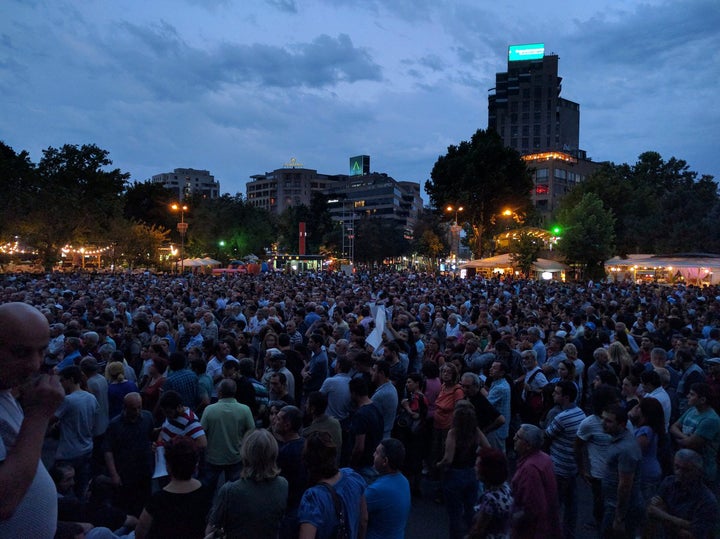
YEREVAN, Armenia — The stand-off between Armenian government forces and gun-toting members of a political fringe group who seized a police station in the capital of Yerevan has ended in the raiders’ surrender.
The question is: What next?
They say cats have nine lives. By my count, President Serzh Sargsyan has used up all nine of his.
Four of those nine lives have been expanded in the anti-government protests that Armenians have staged each of the past four summers. Before this summer’s marches in support of the police-station raiders, there were protests against transit-fare and electricity-rate increases, and pension reform that would have hurt Armenia’s most vulnerable.
The other five lives that Sargsyan has expended have involved non-summer demonstrations.
Many Armenians protested what they considered fraud in the 2008 election that catapulted him into the presidency and in his 2012 re-election victory. They also demonstrated against Russian President Vladimir Putin browbeating Sargsyan in 2013 to reverse Armenia’s plan to join the European Union in favor of the country joining the Kremlin-led Eurasian Economic Union.
There were protests in the spring of 2015 against Armenia’s initial decision to allow a Russian military court, and not an Armenian civil court, to try a Russian soldier who murdered an entire Armenian family in Gyumri, the site of a Russian military base. And there were demonstrations in the winter of 2015 against Sargsyan’s successful bid to force through a change in the constitution that will allow him to stay in office for many more years.
The 20 raiders who were still in the police station on Sunday surrendered exactly two weeks after they and 11 others occupied it.
In seizing it, they killed a top-ranked police officer and wounded two others. That bloodshed made it more difficult right from the start to end the stand-off with a compromise instead of the full-scale raider capitulation that authorities demanded.
The death of a police officer from a sniper’s bullet outside the station in recent days further hardened the authorities’ position on capitulation, although the raiders denied that any of them had fired the fatal shot.
In recent days, police snipers had been picking off the raiders one by one, especially when they ventured outside the station.
Of the 11 occupants who left the facility before Sunday’s mass surrender, nine apparently were wounded and needed hospital care, while two able-bodied men decided they’d had enough.
The sharp-shooters could have put bullets through the brains of those they wounded, but with one exception hit them in the legs — an apparent strategy to avoid creating martyrs that would have stoked occupation hopes of fomenting a general uprising against the government.
The beginning of the end of Viktor Yanukovych’s presidency in Ukraine was when, in the spring of 2014, his forces martyred more than 100 people in the Euromaidan protests in Kiev that had been demanding Yanukovych’s resignation. Sargsyan wanted no repeat of that.
When the raiders seized the station on July 17, they demanded the release of Jirair Sefilian, head of the Founding Parliament fringe party. The government had arrested Sefilian, a hero of the Nagorno-Karabakh War between ethnic Armenians and Azerbaijan, on charges of plotting a coup attempt — allegations his followers have denied.
The station occupiers also demanded that Sargsyan resign.
In the first day or two of the stand-off, only a couple of hundred protesters showed up on the streets near the station to support the occupiers. Most, presumably, were hard-core Founding Parliament supporters.
As the tense drama continued, the demonstrations grew larger — up to 6,000 people at times, according to news accounts — and the participants represented a broader opposition spectrum than Founding Parliament.
The authorities didn’t help their cause by using what independent observers such as the U.S. Embassy in Yerevan, the Organization for Security and Cooperation in Europe, and Transparency International said was excessive force against the protesters.
On the worst night, about 75 demonstrators were beaten, a third of them badly enough to be hospitalized, according to news reports.
Those roughed up included journalists from both Armenian and non-Armenian news organizations.
Before the second police officer was killed, authorities offered the station occupants an amnesty from prosecution if they laid down their arms. And Sargsyan said he would be willing to talk with Sefilian directly — again, on the condition that the raiders surrender first.
It’s unclear whether authorities revoked the amnesty offer and Sargsyan backed away from his offer to talk with Sefilian after the second officer was shot.
But those offers appear to be off the table now.
The leader of the raiders, Varuzhan Avetisian, said the hold-outs had decided to become “prisoners of war” to avoid further bloodshed.
Although the occupation failed to achieve its key goals of getting Sefilian released or forcing Sargsyan’s resignation, Avetisian said, it succeeded in increasing anti-government sentiment that could one day help bring change to the country.
While Sargsyan dodged another bullet by ending the stand-off in a way that keeps him in power, he has to be sobered by the fervor of the opposition to his regime that became apparent during the demonstrations.
Armenians are increasingly frustrated with the country’s widespread poverty, the corruption that has allowed Sargsyan and his cronies to live like potentates, and the shadow the Kremlin casts over the country — one that has already prevented Armenia from casting its economic future with Europe rather than Russia.
The best way for Sargsyan to proceed would be to usher in real economic and anti-corruption reform.
But dictators rarely understand that lesson until it’s too late.
Armine Sahakyan is a human rights activist based in Armenia. A columnist with the Kyiv Post and a blogger with The Huffington Post, she writes on human rights and democracy in Russia and the former Soviet Union.
